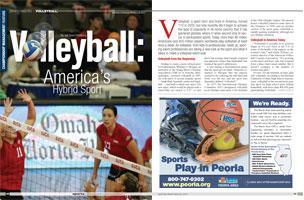
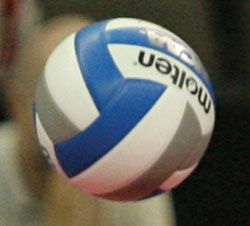 Volleyball, a sport born and bred in America, turned 110 in 2005, but only recently did it begin to achieve the type of popularity in its home country that it has garnered globally, where it ranks second only to soccer in participation sports. Today, more than 46 million Americans and 800 million players worldwide play volleyball at least once a week. As volleyball, from kids to professionals, heats up, sporting event professionals are taking a new look at the sport and what it takes to make a volleyball event soar.
Volleyball, a sport born and bred in America, turned 110 in 2005, but only recently did it begin to achieve the type of popularity in its home country that it has garnered globally, where it ranks second only to soccer in participation sports. Today, more than 46 million Americans and 800 million players worldwide play volleyball at least once a week. As volleyball, from kids to professionals, heats up, sporting event professionals are taking a new look at the sport and what it takes to make a volleyball event soar.
Volleyball from the Beginning
Aiming to create a more refined sport for businessmen, William G. Morgan, an instructor at the Young Men's Christian Association (YMCA) in Holyoke, Massachusetts., invented volleyball in 1895. He took parts of several popular sports - basketball, baseball, tennis, and handball - and built a whole new sport. His new sport, which would be played with a tennis-like net raised to 6'6", or just above the average man's height, required less physical contact than basketball, but retained the sport's athleticism.
It was during a demonstration game that the sport got its name. Someone remarked to Morgan that the players seemed to be volleying the ball back and forth over the net, and the sport was thereafter dubbed "volleyball."
In 1957, the International Olympic Committee (IOC) designated volleyball as an Olympic team sport, to be included in the 1964 Olympic Games. Two-person beach volleyball joined its sister sport in the Olympics in 1996, and yet another version of the sport, grass volleyball, is rapidly gaining popularity, although not yet Olympic attention.
Volleyball in America Today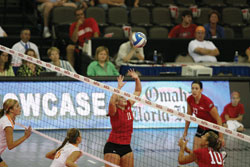 "Volleyball is actually in as good as shape as it's ever been in the U.S. in terms of the health of the support on the women's side," said Kathy DeBoer, executive director of the American Volleyball Coaches Association. "It's growing on the men's and boys' side, but it started from a place that's much smaller. But it doesn't compare to the number of women and girls."
"Volleyball is actually in as good as shape as it's ever been in the U.S. in terms of the health of the support on the women's side," said Kathy DeBoer, executive director of the American Volleyball Coaches Association. "It's growing on the men's and boys' side, but it started from a place that's much smaller. But it doesn't compare to the number of women and girls."
It's true. For the moment, at least, girls rule volleyball. According to the National Federation of State High School Associations, volleyball is the second most popular sport for high school girls, behind basketball, with more than 400,000 girls participating. Volleyball also gained more participants in 2007 than any other sport other than soccer.
"From 1996 to 2006, the number of girls who registered to play junior USA Volleyball, which is our club system, increased by 100,000," said DeBoer. "And at the collegiate level, 96 percent of NCAA colleges and universities sponsor a women's volleyball team."
All those women and girls, as well as the growing number of men and boys who pick up volleyball each year, mean volleyball is a hot sporting event around the nation, and locations with strong volleyball-ready facilities can expect to be very busy in the years to come.
Volleyball Events
The competitive season for volleyball runs basically throughout the year. High school and collegiate volleyball run from fall to spring, while club volleyball, administered through volleyball's nation governing body (NGB) USA Volleyball, picks up in the winter and runs through spring. And volleyball's largest events, such as the Amateur Athletic Union (AAU) Girls' Junior National Volleyball Championships and the giant Volleyball Festival in Reno, take place during the summer.
These events can be a huge draw for the locations that host them.
"The biggest events are over 1,000 teams over a weekend tournament," said DeBoer. "In the last week of June leading up to the fourth of July, 700 teams played [at an event] in Reno, 500 in Louisville, Kentucky.,and almost 800 played in Dallas. That's more than 2000 in just one weekend."
The vast majority of these events are juniors' volleyball tournaments, which means players often travel with at least one parent and more often the entire family comes along. In "heads and beds" terms, that's a major event for a community of any size.
The Volleyball Facility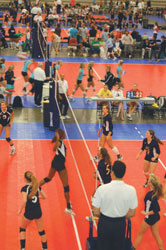 A large percentage of competitive volleyball events are held indoors, and regulation volleyball courts require certain specifications from their facilities.
A large percentage of competitive volleyball events are held indoors, and regulation volleyball courts require certain specifications from their facilities.
Event managers typically take care of the equipment necessary to run an event, such as nets and balls, but one thing every volleyball event facility has to have: 25-foot ceilings.
Another less-critical factor is line of sight. This is not a make-or-break specification; since most volleyball events have multiple courts, event planners can often work around columns or other ceiling supports.But the best facilities for large volleyball events can accommodate a large number of courts with no visual obstruction for the fans.
Outdoor volleyball requires a different kind of facility, with more emphasis on making rooms for spectators-and, in many cases, sand.
Stand-out Volleyball Facilities
Dallas Convention Center
Although you might not immediately think "volleyball" and "convention center" in the same sentence, the Dallas Convention is the prime example of a made-for-volleyball space.
"We're fortunate to have more than one million square feet of usable space," said Tara Green, vice president of sports marketing for the Dallas Convention and Visitors Bureau. "Hall F is the cornerstone of what we do for volleyball, with 203,000 feet of column-free space and 40-foot ceilings."
Hall F may be the focus of Dallas' volleyball game, but the entire convention center can actually be used when needed, and it has.
"For the Mizuno Lonestar Classic, which Dallas has hosted for several consecutive years, they set up over 100 volleyball courts, using our entire convention center," said Green.
The Classic, a qualifying event for the USA Volleyball Junior Olympics, is such a large event that organizers once had to host it in three different locations over three weekends. Thanks to the sizable, ideal space provided by the Dallas Convention Center, however, they've been able to whittle that down to one giant weekend of volleyball excitement.
The Dallas Convention Center delivers more than just space, though. They get the community and even city services involved to support their events. Volleyball nets require large water-filled barrels to anchor the nets, and for a Dallas Convention Center-size volleyball event, that might mean 200 water barrels. No problem, said the Dallas CVB, we'll just call in the fire department to fill those barrels.
For the 2008 Girls Junior Olympic Volleyball Championships, which were held this June, the Center put up 44 courts in 2 halls and hosted more than 40,000 participants and spectators.
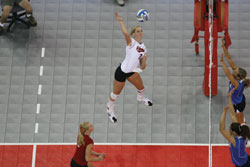 One of the greatest assets of the Dallas Convention Center for a championship volleyball event is the facility's arena. With a 9,000-person seating capacity, the arena allows event planners to set up their championship court ahead of time. When the championship moment comes, spectators and event planners alike can just sit back and enjoy.
One of the greatest assets of the Dallas Convention Center for a championship volleyball event is the facility's arena. With a 9,000-person seating capacity, the arena allows event planners to set up their championship court ahead of time. When the championship moment comes, spectators and event planners alike can just sit back and enjoy.
Reno-Sparks Convention Center
The Reno-Sparks Convention Center is another example of a prime volleyball event space. It has to be: for the past five years, Reno has hosted the nation's largest girls' volleyball tournament, the Volleyball Festival.
The Volleyball Festival, which, in 2008, brought together 700 teams and 7,000 players, is so large that even in Reno one facility won't hold the entire event. The event takes place at sites across Reno, with 74 courts at the Reno-Sparks Convention Center, the event's main site; 12 courts at the Reno Events Center; 12 at the Grand Sierra Resort; three at Bishop Manogue Catholic High School; opening events at Mackay Stadium; and the championship finals at the Lawlor Events Center.
The Volleyball Festival is an excellent example of the potential of Volleyball. In the event's 25 years, the event has grown from a respectable 120 teams to become, according to event planners, the world's largest annual sports event. These days, nothing about the Volleyball Festival is small, especially its impact on its host city Reno. The Reno Sparks Convention Visitors Association estimates that the Volleyball Festival will generate up to 20,000 room nights at 15 area hotels.
Boulder Reservoir, Boulder, Colorado
Boulder, Colorado is just 35 minutes from downtown Denver, perfectly situated for easy airport access as well stunning scenery. And one of its crowning natural glories, Boulder Reservoir, is proof that a beach isn't actually necessary for a perfect beach volleyball event.
"Even when you have a natural beach, it's often not level or the right size. We actually had to ship in sand to support the courts," said Mary Ann Mahoney, executive director of the Boulder Convention and Visitors Bureau. Boulder was the tenth city on the 19-city American Volleyball Professionals (AVP) Crocs Tour, a summer-long, nationwide tour of some of the best volleyball players in the world.
But for a beach volleyball event of this magnitude, sand is just the beginning.
"[Event organizers] are usually looking for a facility large enough to have multiple courts within a reasonable distance of one another,"said Mahoney. "They need plenty of available parking, and we also offer a partnership with the host organization, which for us was the University of Colorado athletics department."
The AVP Crocs Tour also happens to be a great match for Boulder.
"Boulder is such a health and fitness community, it was a very nice fit,"said Jan Geden, parks and recreation director for the city of Boulder. "The energy of the crowds, the fun people were having - it's just a nice event that supports the values of this community. And it's definitely professional so you get to see some really great play."
Of course, cities with natural beaches, particularly ones already used for volleyball, make great facilities for beach volleyball events.
"One aspect [of a great facility] is the sand. In some areas, especially down South, the sand is very soft, no shells. Those are some of the best venues," said Carlos Jimenez, director of operation, player & event relations for Extreme Volleyball Professionals. "The second aspect is the beach. When it is already used for volleyball, and the city takes care of the area, we're able to use it right away without having to prepare very much."
Bring the Heat
It's no secret. volleyball is one of America's fastest-growing sports, and there are a lot of communities that are willing and ready to get in the game. For a hard-hitting volleyball event that ensures athletes and fans walk away wishing for more, get started with a few simple steps:
The right location. Just like AVP and Boulder, you want to find a location that has more than just the right facility. For spectator-driven events, you want a volleyball-friendly community, and for junior volleyball events, make sure to take local attractions and events athlete down-time into consideration.
The right facility. Indoor facilities must be regulation size, but as long as the ceilings are at least 25 feet high with no dangling lights, you can work with all kinds of configurations, depending on your event's size.
The right planning. For the best-possible event, find a Convention Visitors Bureau that will work with you to coordinate community and city support, as well as local collegiate or professional partnerships if possible. Start with the most support you can get, and you'll finish at the top.

